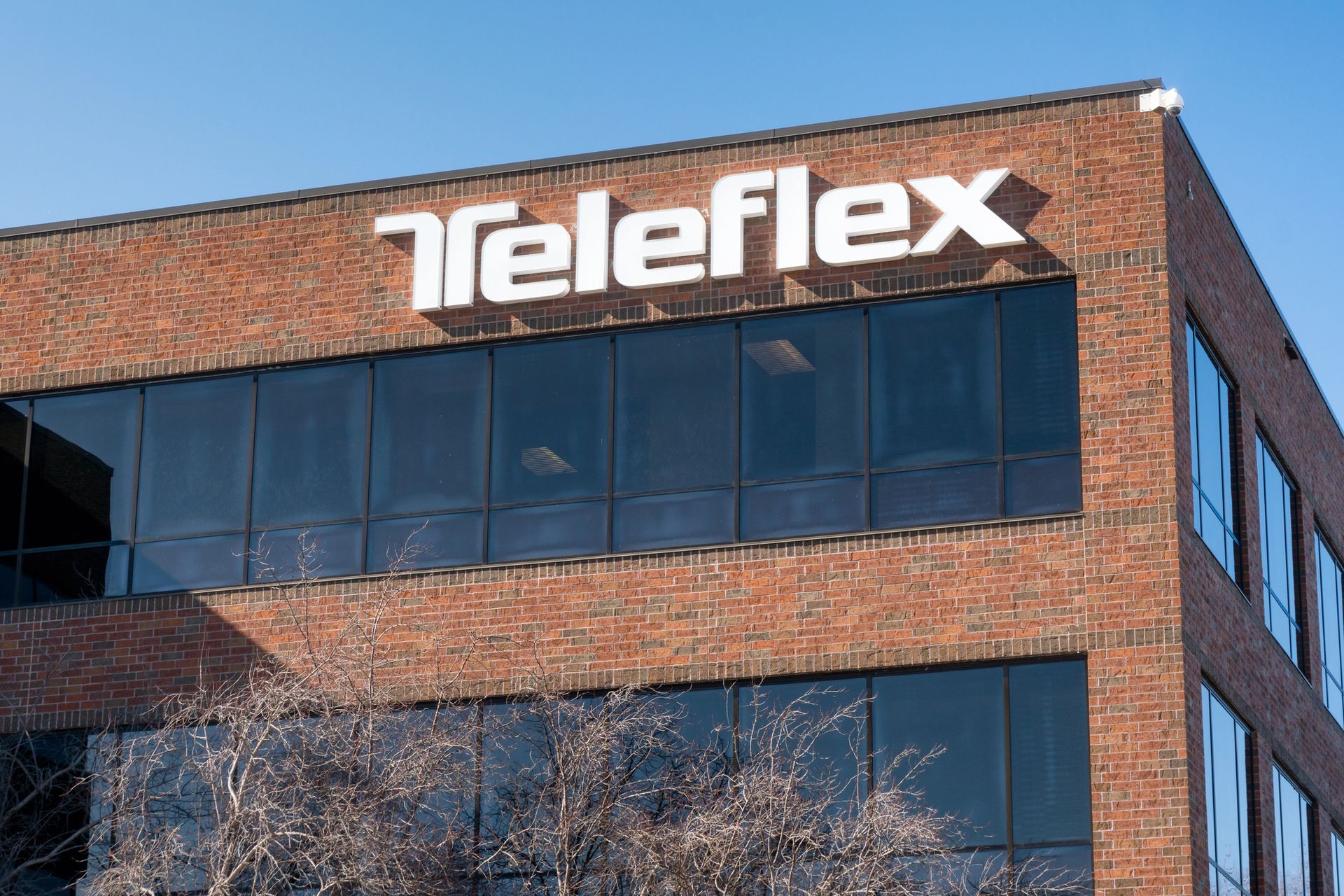
After years of uneven sentiment around hospital volumes and post-pandemic demand swings, Teleflex (NYSE: TFX) is starting to show real consistency again.
The stock is up ~20% off its 52-week lows and now trades around the mid-$230s, but it's still well below the $400+ range it commanded at its peak.
What's changed? Guidance is back on track, free cash flow is stabilizing, and medtech demand across vascular and anesthesia is holding steady.
Management finally looks like it believes in its own growth story.
For those of us who have watched TFX trade sideways while peers regained altitude, this feels like a genuine inflection point.
Action: Accumulate shares between $225–$240 ahead of Q3 earnings and year-end hospital procedure volume updates.
Execution could push the stock toward the $260–$270 range as confidence returns.

Market Edge (Sponsored)
This Quarter has kicked off amid a whirlwind of market volatility and geopolitical shifts, tightening U.S.-China trade policies, and global supply chain disruptions.
What if you knew which stocks would thrive despite these challenges?
I’m thrilled to offer you exclusive access to our free report, “Top Seven Stocks for 2025.”
This isn’t just another list; it’s your personal blueprint for navigating uncertain times and seizing hidden opportunities.
Here’s why this guide is a must-have:
Booming Sectors: Handpicked stocks from industries primed for explosive growth.
Data-Driven Insights: Clear, actionable analysis you can trust.
Proven Strategies: Tactics that even seasoned investors are leveraging now.
Don’t let uncertainty hold you back.

Why the Market Overcorrected & What Comes Next
For most of the last two years, Teleflex was stuck in the same "surgical slowdown" narrative as the rest of the industry.
Hospitals were delaying procedures, staffing was tight, and investors dumped anything tied to elective volumes.
TFX got painted with the same broad brush: slow growth, margin pressure, no spark.
The reset looks overdone. Q2 showed real progress: $785 million in revenue (+5% YoY), adjusted EPS at $3.44, and full-year guidance reaffirmed at $13.50–$13.75.
Importantly, the high-margin Interventional and Anesthesia segments are stabilizing, giving investors a clear view of consistent cash generation again.
Despite that, TFX still trades at just ~17x forward earnings, well below pre-COVID medtech averages that routinely commanded 22–24x. That gap screams skepticism.
To me, Wall Street is clinging to an outdated story of a "post-pandemic laggard" when what we're seeing now looks more like a quiet rebuild.
From my seat, the setup is straightforward: Teleflex is a high-quality medtech name steadily regaining credibility.
Hospital procedure volumes are recovering, new products are hitting, and cost discipline is showing up in the numbers, yet the market hasn’t caught on.
This isn’t a hypergrowth play, and that’s exactly what makes it compelling as a late-cycle value trade.

Precision. Patience. Profit (Sponsored)
What if you knew EXACTLY what to look for in a trade before you took it?
Better yet...
What if you also didn’t have to risk a fortune to target 100%, 300% or even 1,000% within days... or even HOURS?
Over the past few years, Millionaire Trader Nate Bear has been using a special $2 (or less) trade to collect MASSIVE returns, like....
$65 into $800 in 2 days...
$246 into $903 within hours...
$305 into $1,205 overnight...
$1,250 into $11,540 overnight...
Or even $3,650 into $14,677 overnight...
He calls them “lotto trades”...
And they’re a big reason why he was able to turn $37k into $2.7 Million in just 4 years.
And on Wednesday, August 27th @ 2 P.M. ET during his first-ever 10X Lotto Trade Summit...
He's going LIVE to walk you through EXACTLY what he looks for when targeting these lotto trades...
And he’s even going to place a live trade or two to give you an opportunity to see just how lucrative these trades can be.
CLICK HERE TO RESERVE YOUR FREE SPOT

Premium & Innovation Is the Spark
Teleflex isn't winning on volume gimmicks or low-end pricing; it's leaning into premium categories where margins stick and hospitals can't easily substitute.
The core playbook is about devices that are procedural, recurring, and hard to cut from budgets.
What's working:
Urology & Interventional Access: Flagship products like UroLift (a minimally invasive BPH treatment) continue to expand share in a massive market.
Vascular & Anesthesia Devices: These are "must-have" tools in ORs and ICUs, not optional add-ons. That translates into steady demand even with tighter hospital budgets.
Innovation Pipeline: Research and development spending is targeted, with fewer moonshots and more incremental upgrades that keep pricing power intact.
Global Growth: Emerging market adoption is finally gaining traction, diversifying revenue away from just U.S. hospital cycles.
This isn't a medtech name chasing flashy robotics headlines; it's a steady compounder in high-value niches.
If Wall Street starts giving credit for innovation-driven cash flow instead of punishing it for past volume softness, the multiple has room to expand meaningfully.

AI Boom Ahead (Sponsored)
The AI revolution isn’t coming — it’s already here. And it’s moving faster than most investors realize.
Zacks has just released a new report revealing 5 AI stocks positioned to capture this trillion-dollar disruption.
Among them is a sleeper stock still flying under Wall Street’s radar.
Bank of America projects AI’s impact could exceed $15 trillion by 2030. That means fortunes will be made — but only by those who get in early.
You don’t need to chase hype. These are real companies with real growth potential.

Buybacks and Policy Risk Are Now Center Stage
Teleflex isn't splurging on mergers and acquisitions right now; it's quietly signaling confidence the old-fashioned way, through capital returns.
Buybacks: Management authorized a fresh $500 million repurchase program earlier this year, a clear message they see TFX stock as undervalued at current multiples.
Balance Sheet: Net leverage sits under 2.5x EBITDA, giving room to fund buybacks without stressing operations.
Cash Flow: With ~$650 million + expected in annual free cash flow, Teleflex has the firepower to keep rewarding shareholders.
There's always a caveat. On the policy side, medtech pricing scrutiny is back on D.C.'s radar.
Proposals tied to Medicare reimbursement and device excise taxes have been floated, which are not thesis-breaking, but are enough to spook multiples in the short-term if they gain traction.
Internationally, regulatory lag in Europe (MDR approvals) is still slowing some product launches.
The key: Teleflex isn't overexposed to any single policy lever.
Diversified product lines across interventional, urology, and anesthesia mean even if one category gets squeezed, the portfolio still throws off strong, sticky margins.

Don’t Let These Undervalued Stocks Slip Through Your Fingers!
We now send our favorite value picks via text, too, so you’ll get the same actionable news without having to open your inbox.

Teleflex Is Starting to Look Like a Real Setup Again
Medtech isn’t flashy, but it’s stabilizing fast, with Teleflex right in the middle of it.
Procedure volumes are recovering, supply chains are normalizing, and hospitals are relying more heavily on premium devices to manage backlogs and margins.
That’s the kind of backdrop where a company like Teleflex can quietly build momentum.
Here’s what’s working:
Elective Volumes Are Back: Urology and access products are seeing stronger demand as hospitals move through deferred care.
Margins Are Holding Up: Gross margin stayed above 55% in the latest quarter, supported by pricing and a favorable mix.
Targeted Launches Are Hitting: New interventional tools are landing in the right procedural areas, without bloating the cost base.
Demographics Still Help: Aging patients and chronic conditions keep the demand side steady.
Valuation is still under 19x forward earnings, even after management reinstated guidance and raised the dividend. It’s not chasing biotech multiples, it’s earning them.

Risks and Re-Rating Potential
Teleflex still has things to prove. Reimbursement pressure could eat into margins if CMS or private insurers start tightening coverage.
Bigger players with wider reach — like BD and Medtronic — remain a threat in overlapping product lines.
Input costs haven’t fully settled either, especially on the labor and logistics side. Expectations are rising now that management has reinstated guidance and returned to capital deployment.
One slip on earnings could knock sentiment off course.
But the setup is still tight. The stock trades at a discount to other medtech names, even with strong cash generation, a higher dividend, and a much cleaner balance sheet.
If the next couple of quarters stay on track, a re-rating isn’t a stretch.
The market is starting to reward reliability again, and Teleflex is moving back into that conversation.

Poll: If your net worth grew every time you learned a new skill, what skill would you master first?

Final Word: Betting on the Rebuilders
Teleflex isn't chasing a moonshot story; it's rebuilding the kind of credibility investors actually pay for: steady margins, recurring cash flow, and targeted innovation.
After a stretch defined by supply chain headaches and cautious guidance, the company has flipped the script by reinstating forecasts, raising dividends, and signaling confidence through buybacks.
The market, for now, is still treating TFX like a second-tier medtech name. But with demographics, procedure growth, and product strength all tilting in its favor, the setup looks like a textbook value re-rating opportunity.
For investors willing to lean into visibility over hype, Teleflex stands out as one of the cleaner late-cycle medtech plays on the board.

Action Recap (Checklist)
✅ Buy Zone: Accumulate shares in the $195–$205 range, before Q3 results and capital return momentum drive sentiment higher.
✅ Catalysts to Watch: An uptick in interventional product sales, dividend growth, and commentary on procedure volumes heading into 2026.
✅ Medium-Term Target: $225–$235, reflecting a normalized multiple on steady EPS growth and improved free cash flow visibility.
✅ Risk Management Tip: Keep an eye on reimbursement shifts, competitive launches, and cost inflation. Trim exposure if margins soften despite stable demand.
Teleflex is showing the fundamentals, with cleaner execution, dividend hikes, and balance sheet discipline, but the market hasn't caught on yet.
For value-focused buyers, that's exactly the kind of setup worth paying attention to.

That’s our coverage for today, thanks for reading! Reply to this email with feedback or any names you want us to dig into next.
Best Regards,
—Noah Zelvis
Undervalued Edge




